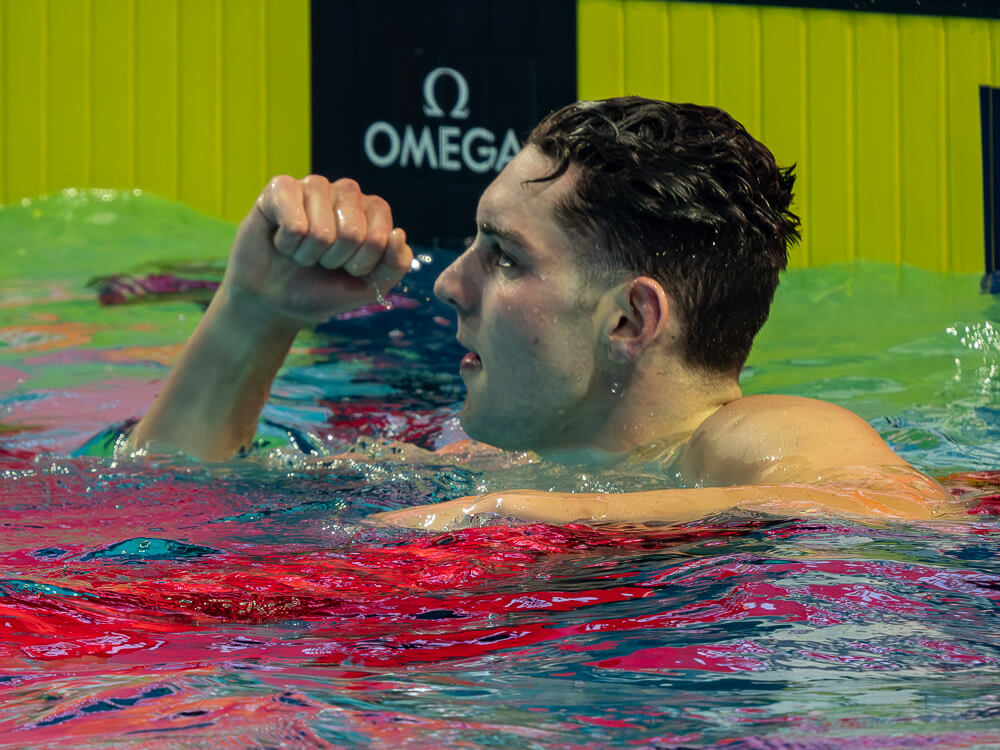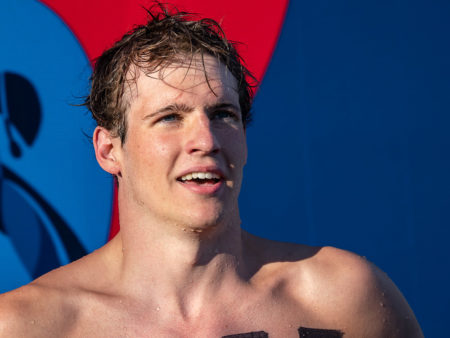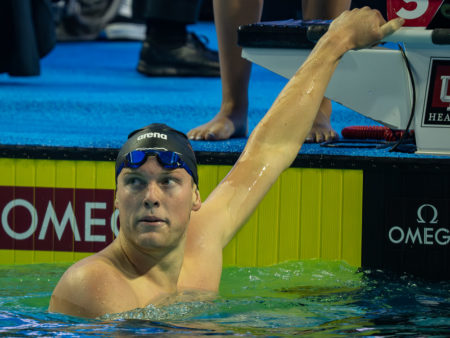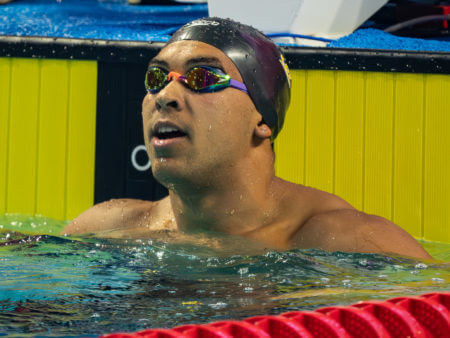U.S. Men’s Relays Will Rely on Emerging Young Swimmers at Paris Olympics (Full Relay Analysis)

Editorial content for the 2023 World Aquatics Championships is sponsored by FINIS, a longtime partner of Swimming World and leading innovator of suits, goggles and equipment. U.S. Men’s Relays Will Rely on Emerging Young Swimmers at Paris Olympics (Full Relay Analysis) On one hand, the American men won only two individual gold medals at the World Championships, with Ryan Murphy scoring his first world title in the 100 backstroke in upset fashion on day three before Hunter Armstrong concluded the meet with his 50 back win. But at the same time, the future of this team began to take shape after years when stars like Murphy, Caeleb Dressel and Bobby Finke obscured gaping holes. Now, some of the young men who made their senior international debuts in Fukuoka will be counted upon to play big roles moving forward, both individually and on relays. The new-generation phenomenon was particularly evident in the men’s 400 freestyle relay. For the first time since before the 2016 Olympics, Dressel was not handling the leadoff. In fact, no swimmers who were part of that squad in either prelims were even present two years ago in Tokyo. Ryan Held is a veteran who swam at the 2016 Olympics and again at last year’s Worlds while Justin Ress, who raced only in prelims, appeared on this relay at last year’s Worlds. The three men who joined Held on the finals squad, Jack Alexy, Chris Guiliano and Matt King, along with prelims swimmer Destin Lasco, were all rookies. Matt King — Photo Courtesy: Peter H. Bick And even as the Americans did not earn gold in this relay for the first time since Dressel’s entrance to the squad, the young guys showed up, all producing splits between 47.3 and 47.8. Held’s leadoff leg was more than a half-second off his season-best time from U.S. Nationals, but if he had replicated that 47.63, the Americans would have been right with eventual gold medalists Australia. In these rookies, the U.S. might have found some keepers, with all four currently 20 or 21 years old. King looks like a big-time relay performer after he again split 47.3 in the U.S. men’s medley relay in prelims while later on at Worlds, Alexy became just the third American man in the last 20 years to medal in both the 50 and 100 free at a global-level competition, joining the likes of Dressel and Nathan Adrian. Now imagine Alexy and co. teamed up with a resurgent Dressel next year. We have no idea what Dressel is capable of in his return after a long layoff, and while winning three Olympic gold medals at a second consecutive Games seems unlikely, it is certainly plausible that Dressel returns to 47.5-ish 100 free form and the ability to lift this relay in major competition. Of course, the foreign opposition in the 400 free relay has stiffened in recent years. Australia won gold thanks to Kyle Chalmers, who just won his first world title in the 100 free, and its own pair of newcomers, 19-year-old Kai Taylor and 18-year-old Flynn Southam. Italy has a deep group that has reached the podium in three consecutive major meets while Great Britain might have dropped a sub-3:10 relay performance if not for the team’s prelims disqualification in Fukuoka. Tough competition? Plenty, but the Americans have to like their positioning one year out from Paris. Unlike previous occasions when long U.S. winning streaks have been broken in this event, don’t expect a long wait before a return to gold. In the 800 free relay, the U.S. men will expect to see a very similar challenge to the one that derailed their world-title defense in Fukuoka. Great Britain, still in pursuit of a 14-year-old world record, will try to become the first country to repeat as Olympic titlist in any relay with the exact same four men involved. At Worlds, it was Duncan Scott, Matt Richards, James Guy and Tom Dean producing gold, just like they did in Tokyo, albeit in a different order. Richards and Guy were the gold and silver medalists, respectively, in the individual 200 free while Scott and Guy are both past international medalists. The key for the American men to overcome that 94-hundredth gap, just like in the 400 free relay, is the correct mix of youth and experience. Kieran Smith was part of the American relay that missed the podium in a stunning result in Tokyo, and amid an otherwise-disappointing Worlds, Smith was electric in relay duty as he anchored in 1:44.47 while facing a long-shot comeback bid against Dean. Carson Foster has performed well on this relay two consecutive years, including in his 1:44.49 split in Fukuoka that actually out-split Richards. Luke Hobson — Photo Courtesy: Peter H. Bick It would help if Drew Kibler, also another relay final swimmer in Tokyo, can return to the 1:45.0 flat-start form that netted him fourth place in the Worlds 200 free final last year. Kibler actually surrendered his finals spot this year to former Carmel teammate Jake Mitchell, a 21-year-old who was a 2021 Olympic finalist in the 400 free but swimming an international relay for the first time. Mitchell, too, performed admirably in Fukuoka. As for the younger side, this year’s prelims relay featured Baylor Nelson, 20, and Henry McFadden, who will celebrate his 18th birthday Friday. Looking further down in the American rankings, you could see college swimmers like Gabriel Jett or Patrick Sammon get into the mix or even teenagers Maximus Williamson and Thomas Heilman. But the centerpiece swimmer to this relay is Luke Hobson, who now sits squarely in the position of the country’s best in the event. Hobson’s massive drops within the last two summers have lifted him from just off the Worlds team in April 2022 to 1:46-low at the end of the summer to 1:44.87 in the 200 free semifinals at Worlds this year. Hobson dropping further down into the 1:44s would be no surprise and a welcome development for the U.S. team. He did struggle in his first relay final at a major meet, fading down the stretch to touch in 1:46.00, but if he can learn from that experience, he will be in a stronger position to help the Americans challenge the Brits one year from now. Australia will pose a challenge here as well, with a range of options to choose from including Taylor, who split 1:44.56 in prelims in Fukuoka, and Thomas Neill, who anchored the team to bronze this year, but it would take a surprising development for the gold-medal battle to include countries other than Great Britain and the U.S. The confidence that combining American veterans and young talent can produce gold-medal relays comes from the performance of the men’s 400 medley relay team in Fukuoka. Two veterans, each racing in their fifth World Championships, came through on the front end, and two newcomers matched their impressive results from individual events to finish off a gold medal. Similarly, there’s plenty of believe in this group moving forward to 2024. Ryan Murphy has been entrenched as the leadoff swimmer on this relay since 2015, and even in the unlikely event he falters next year, there are plenty of talented American backstrokers behind him. Nic Fink’s second act as one of the world’s top sprint breaststrokers has been remarkable, although as we look to the future, note that Fink is 30 years old and the gap to the next-best American man in the event is one second. Dare Rose — Photo Courtesy: Peter H. Bick Behind that duo on the medley relay were Dare Rose and Alexy, both coming through despite the nerves of the big moment. Neither man has turned 21 yet, and both will spend the next year under the watchful eye of Cal coach Dave Durden and also of Murphy. The X-factor? Dressel, whose 49.03 split helped the American men to Olympic gold in world-record time in Tokyo. The Americans have won this medley relay in every Olympics in which they have participated, with the exception of the boycotted 1980 Games. The biggest threat to American domination is not 2022 world champion Italy or either of the 2023 medalists, China or Australia. Neither country has a huge upside play likely to make a significant change to the status quo in the next year. Great Britain, on the other hand, is hoping to welcome back Adam Peaty and his 56-second breaststroke splits. Insert the 56.53 that Peaty posted in Tokyo into this year’s fifth-place relay team, and the Brits are already up to silver. Britain may have finally found a backstroker in 20-year-old Oliver Morgan, and Richards split 46 on freestyle multiple times this year. Get some improvement on the butterfly, where Guy and Jacob Peters both struggled this year, and that’s a gold-medal-capable group. Yes, the Americans sit in pole position in the medley instead of chasing as in the freestyle relays, but plenty can change in one year. All three relays will depend on consistent swimmers like Murphy and Smith maintaining their usual excellence and that young bunch of Alexy, Hobson, Rose and others channeling their Fukuoka introduction into international racing into improved preparation and confidence for 2024. And of course, the return of Dressel would not hurt.









